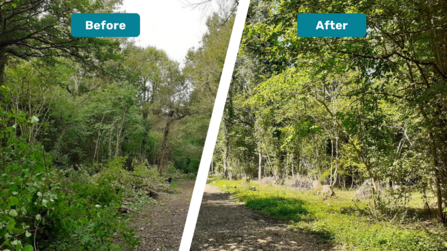Ash dieback, Hymenoscyphus fraxineus, is a fungus which originated
in Asia. While it doesn’t cause much damage to the ash trees in its native range, its introduction to Europe about 30 years ago has been devastating native European ash species. They didn’t evolve with the fungus, and therefore have no natural defence against it.
Ash is estimated to account for more than 10% of the canopy in 90% of woodlands in the county and, in some cases, it forms 80-100% of the canopy.
While ash dieback is destructive and felling work can seem harsh, we like to look for the silver linings - such as the creation of new open habitats!
Last year, GWT staff descended upon Lower Woods to give the land management team a helping hand on a frequently used path. The first photo shows how the woodland path looked at the end of the day, while the second photo shows it this week.

